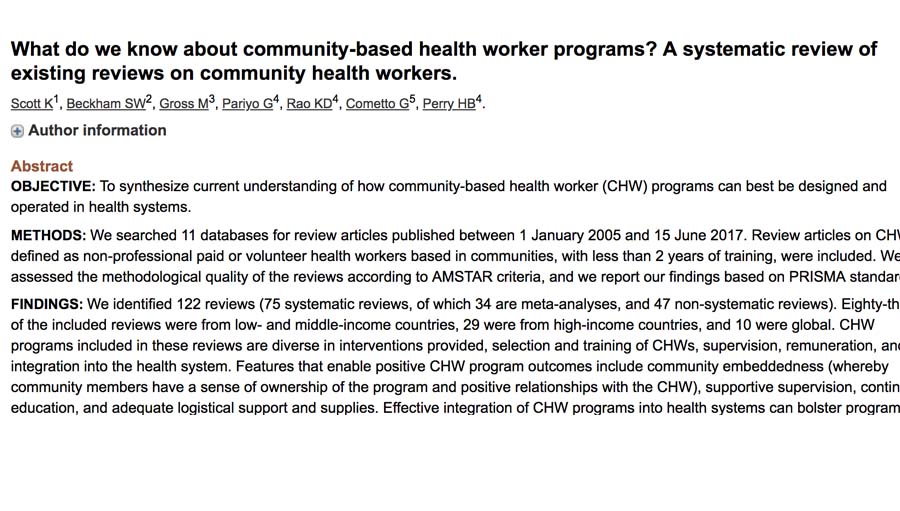Join a powerful, unprecedented alliance for better eye health for all.
Join IAPB-
Choose an alternate language here
 Community Health Workers: Review of Reviews
Community Health Workers: Review of ReviewsK. Scott, S. W. Beckham, M. Gross, G. Pariyo, K. D. Rao, G. Cometto & H. B. Perry, What do we Know about Community-based Health Worker Programs? A Systematic Review of Existing Reviews on Community Health Workers, Human Resources for Health, 2018, 16.
FINDINGS:
We identified 122 reviews (75 systematic reviews, of which 34 are meta-analyses, and 47 non-systematic reviews). 83 of the included reviews were from low- and middle-income countries. CHW programs included in these reviews are diverse in interventions provided, selection and training of CHWs, supervision, remuneration and integration into the health system.
Features that enable positive CHW program outcomes include community embeddedness (whereby community members have a sense of ownership of the program and positive relationships with the CHW), supportive supervision, continuous education, and adequate logistical support and supplies. Effective integration of CHW programs into health systems can bolster program sustainability and credibility, clarify CHW roles, and foster collaboration between CHWs and higher-level health system actors. We found gaps in the review evidence, including on the rights and needs of CHWs, on effective approaches to training and supervision, on CHWs as community change agents, and on the influence of health system decentralization, social accountability, and governance.
CONCLUSION:
Evidence concerning CHW program effectiveness can help policymakers identify a range of options to consider. However, this evidence needs to be contextualized and adapted to inform policy and practice. Advancing the evidence base with context-specific elements will be vital to helping these programs achieve their full potential.
SELECTED EXTRACTS:
‘We defined CHWs as health workers based in communities (i.e., conducting outreach from their homes and beyond primary health care facilities or based at peripheral health posts that are not staffed by doctors or nurses), who are either paid or volunteer, who are not professionals, and who have fewer than 2 years training but at least some training, if only for a few hours. Adhering closely to this definition led us to include some programs, such as those for peer supporters and traditional birth attendants with some training that reflect divergent and context-specific understandings of the term “CHW.”’
A new update of the Cochrane EPOC review on nurses as substitutes for doctors in primary care. A team of Cochrane authors based in the Netherlands, Thailand, and the United Kingdom worked with Cochrane Effective Practice and Organisation of Care to update the 2005 Cochrane Review that investigated the impact of nurses working as substitutes for primary care doctors on: patient outcomes; processes of care; and utilisation, including volume and cost. Nine randomized trials were added to this update, bringing the total examined to 18.
One study was conducted in a middle-income country, and all other studies in high-income countries.
In summary, the review update found that delivery of primary healthcare services by nurses instead of doctors probably leads to similar or better patient health and higher patient satisfaction. Nurses probably also have longer consultations with patients. Using nurses instead of doctors makes little or no difference in the numbers of prescriptions and tests ordered. However, the impacts on the amount of information offered to patients, on the extent to which guidelines are followed and on healthcare costs are uncertain. Read the full
Open Access Cochrane Review:
http://cochranelibrary-wiley.com/doi/10.1002/14651858.CD001271.pub3/abstract
Ramke, Jacqueline et al. Strengthening Eye Health Evidence for Children in Low-Income and Middle-Income Countries, The Lancet Global Health , Volume 6 , Issue 8 ,
Wong, San, et al.,Guidelines on Diabetic Eye Care, International Council of Ophthalmology, Recommendations for Screening, Follow-up, Referral and Treatment based on Resource Settings, American Academy of Ophthalmology, (In Press)
Courtright, Rotondo et al., Strengthening the Links Between Mapping, Planning and Global Engagement for Disease Elimination: Lessons Learnt from Trachoma, BJO, 15thJune, 2018
Smith, A. F., & Negretti G., Glaucoma Control Strategies in Sub Saharan Africa: A Review of the Clinical and Health Economic Strategies, Ophthalmic Epidemiology, 10, 2018
Yin-Chung, T., & Xiang, l., Global Prevalence of Glaucoma and Projections of Glaucoma Burden through 2040: A Systematic Review and Meta-Analysis,American Academy of Ophthalmology, 2014
Courtright P., &, Rotondo L., et al, Strengthening the Links between Mapping, Planning and Global Engagement for Disease Elimination: Lessons Learnt from Trachoma, BJO, 2018
Lamoureaux, E. L., & Pallant J. F., The Effectiveness of Low Vision Rehabilitation on Participation in Daily Living and Quality of Life, IOVS, April, 2007
Khanna, R. & Rao, G. N., Presbyopia and the Sustainable Development Goals, The Lancet, on-line 18 July 2018
White, C., Changing Trends in Mortality and Health in England and Wales: 1990-2017 (Experimental Statistics), Office for National Statistics, 2018.
Harris C, Green S,. et. al, Sustainability in Health Care by Allocating Resources Effectively (SHARE) 1: Introducing a Series of Papers Reporting an Investigation of Disinvestment in a Local Healthcare Setting. BMC Health Serv Res. 2017 May 4;17(1):323.
K. Scott, S. W. Beckham, M. Gross, G. Pariyo, K. D. Rao, G. Cometto & H. B. Perry, What do we Know about Community-based Health Worker Programs? A Systematic Review of Existing Reviews on Community Health Workers,Human Resources for Health, 2018, 16.
van de Klundert, J., van Dongen J., et al., ‘We are Planning to Leave, All of Us’: A Realist Study of Mechanisms Explaining Healthcare Employee Turnover in Rural Ethiopia, Research Article, Human Resources for Health, 13 August, 2018.
P.P. Gile, M. Buljac-Samardzic & Van De Klundert, J, The Effect of Human Resource Management on Performance in Hospitals in Sub-Saharan Africa: A Systematic Literature Review,Human Resources for Health, 2018,16:34